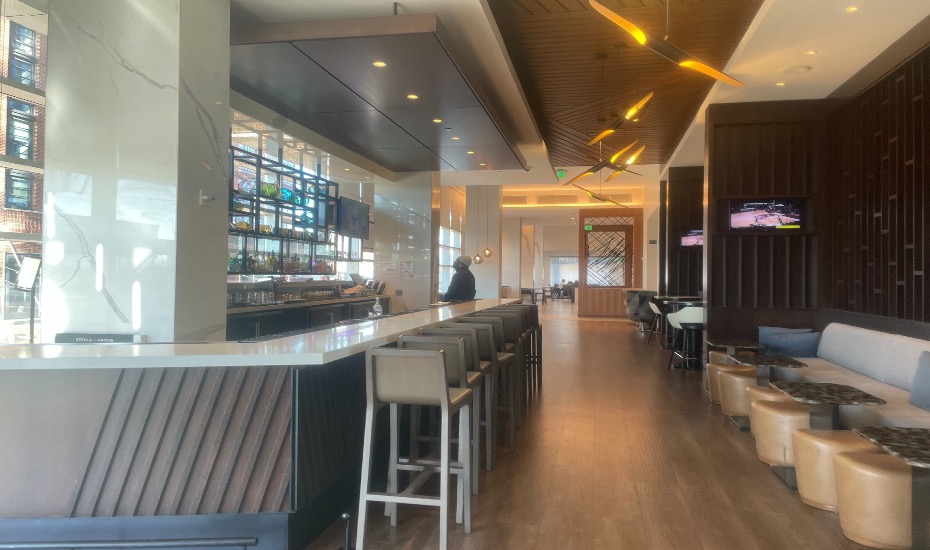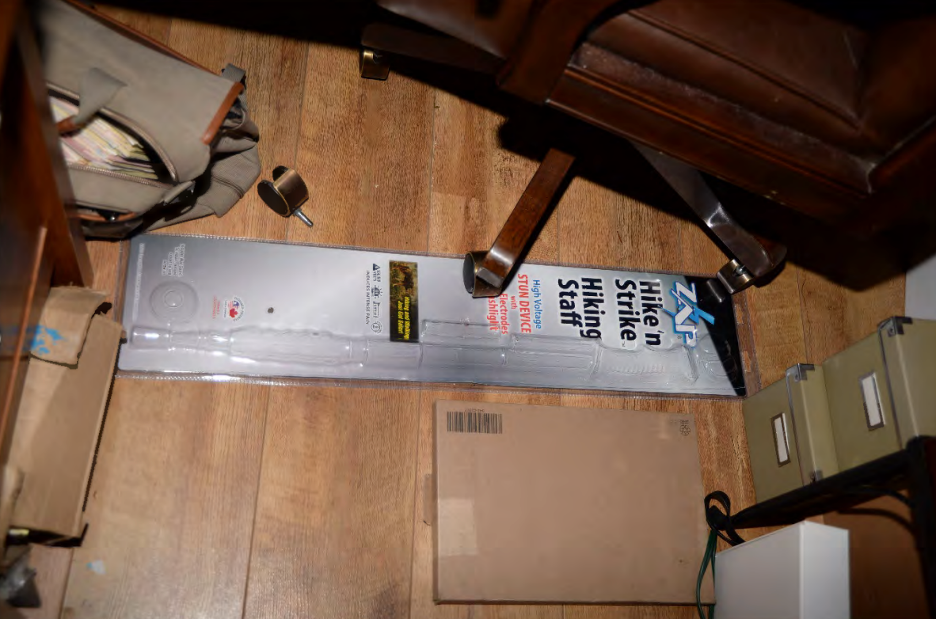WASHINGTON — Richard “Bigo” Barnett is expected to testify in defense of his actions in the Jan. 6 riot at the U.S. Capitol, Brad Geyer, one of his lawyers, announced Tuesday. The prosecution is on track to rest its case Wednesday afternoon and Barnett could take the stand as early as Thursday.
The Gravette, Arkansas man, who was photographed with his feet on the desk of former-House Speaker Nancy Pelosi (D-Calif.) is facing eight charges for his role in the riot, including possession of a dangerous weapon, theft of government property, and disruption of an official proceeding.
Barnett has pleaded not guilty to all charges.
The prosecution called over 10 witnesses across six days. As the jury prepares for defense attorney Joseph McBride’s opening statement Wednesday, here are three takeaways from the last three days of testimony.
Prosecutors argue Barnett went to the Capitol “prepared for violence”
From its opening statement to its last witness, the prosecution argued Barnett went to the Capitol on Jan. 6 to do more than just peacefully protest.
“He came prepared for violence,” said Assistant U.S. Attorney Allison Prout last week.
Barnett, 62, began preparing for his trip to Washington weeks before he arrived on Jan. 5. He purchased a 950,000-volt stun gun, multiple radios and pepper spray from a Bass Pro Shops in Rogers, Arkansas on Dec. 31, 2020, according to evidence presented by the prosecution.
Surveillance footage from the Hyatt House in Washington D.C. captures Barnett showing off his ZAP Hike n’ Strike at the hotel bar on the eve of the attack. The video shows Barnett activating his stun device in front of a crowd, which prompted management to close the bar early, according to hotel employee Zachary Wendel.

The Hyatt House hotel bar where Richard Barnett showed off his stun gun on Jan. 5, 2021. (Logan Schiciano/MNS)
While multiple photographs from Jan. 6 show Barnett with the stun device strapped to his waist, it’s unclear if he brought the other items purchased at Bass Pro Shops to the Capitol.
In court Tuesday, FBI Special Agent Kimberly Allen demonstrated use of the electric shock feature of the Hike n’ Strike for the jury. She activated the device for five seconds. One juror was seen covering her mouth. Another reacted to the loud noise by putting her hands over her ears.
Barnett wrote on Facebook on Dec. 24, 2020 that he planned to “peacefully protest,” but also commented the night before the Capitol attack that he “didn’t drive all the way up [to Washington, D.C.] to sing kumbaya.”
Barnett’s activity on social media continued into the early morning hours on Jan. 6. Just after midnight, he wrote, “We aren’t here to play. We own this. This is ours.” He also posted a video that morning where he said, “I’d like to see some Proud Boys out here,” according to evidence presented by the prosecution.
“He came to do something to, in his mind, make a difference, not just peacefully protest,” FBI Special Agent Kimberly Allen said.
In a Dec. 28, 2020 post, Barnett revealed that he reserved a “bug out” room to “crash in safety” on the evening of Jan. 6 before the 18-hour drive back to Arkansas. But Barnett never checked-into that hotel on Jan. 6. Instead, he drove home that night, turning off his location services, paying with cash and covering his face along the way, according to testimony from FBI Special Agent Jonathan Willett.
Barnet’s time at the Capitol included a tense exchange with an officer
Police body camera footage captured Barnett shouting profanity and threatening Metropolitan Police (MPD) Officer Terrence Craig inside the Capitol Rotunda.
Shortly after Barnett posed for the photo in Pelosi’s office and took an envelope off an aide’s desk, he is seen pleading with Craig to retrieve his flag, which he said he left in the office.
“Be a patriot and get my flag,” said Barnett, who was gifted the flag from a state senator. “I’ll die for my flag. Get my f***ing flag.”
Craig, who was holding back protestors, refused.
“That’s the last thing I wanted to do,” said Craig, who has been a MPD officer for 12 years. “[My mission was] to get rioters out of the Rotunda.”

Metropolitan Police Department Officer Terrence Craig outside the D.C. District Courthouse on Jan. 12, 2023. (Mark Naughton)
But instead of backing down, Barnett escalated the conflict.
“I’m gonna make it real bad if you don’t get my flag. I’m gonna call ‘em in,” said Barnett, while motioning for more protesters to join him at the front of the line.
Craig said he considered Barnett’s actions a “threat to do bodily harm.” While Barnett left the Capitol minutes after the exchange, the officer said the interaction left a lasting impact.
“It’s not easy to watch. It could’ve gotten a lot worse,” Craig said last Friday.
While Craig said Barnett breached his “personal space” by using his phone to record the altercation, he acknowledged during cross-examination that the defendant never kicked or punched him inside the Rotunda.
“I would do it again”: Barnett appears to double down on his actions
The days after Jan. 6 saw the execution of two search warrants on Barnett’s home, a lengthy interview and Barnett’s self-surrender at the Benton County Sheriff’s office.
Just before Barentt turned himself in on Jan. 8, he engaged in a nearly 2-hour interview with FBI agents in Arkansas. Video from the interview presented by the prosecution shows Barnett discussing everything from his march to the Capitol on Jan. 6, to his belief that Joe Biden didn’t win the 2020 election – all while striking a familiar pose.
“We were in there for just a minute or two and he had kicked his feet up on the desk and then asked us ‘Does this look familiar?”’ Willett said during his testimony Tuesday. “He asked that several times.”
While Willett said Barnett initially expressed some remorse for his role in the attack, he said Barnett doubled-down on his actions by the end of the interview.
“He said, ‘I really don’t regret it. I would do it again.’” Willett said.
After Barnett self-surrendered on Jan. 8, he was booked into the Washington County Detention Center. That afternoon, a search warrant was executed at his home in Gravette, Arkansas. A second search warrant was executed on Jan. 11 after the FBI learned Barnett carried a stun gun to the Capitol, according to the testimony from the FBI agent coordinating the search.

The ZAP Hike n’ Strike packaging was found at Barnett’s home on Jan. 11, 2021. The stun gun was never found. (Department of Justice)
While the FBI found the stun gun packaging, it never found the actual weapon or Barnett’s phone at his residence, according to Special Agent Loel Skoch.
Hours after Barnett left the Capitol on Jan. 6 he was labeled a “Tier I Terrorist” by the FBI – a designation that would put him on a level with the likes of Osama bin Laden, the defense said.
“He’s everyone’s crazy uncle, but he’s no Osama bin Laden,” McBride said last Friday.
During Allen’s testimony Monday, the prosecution said this label was “not a measure of dangerousness,” but instead used because, at the time, it was unclear if Barnett was acting alone or with a group.



